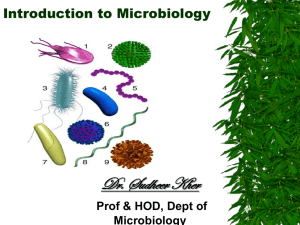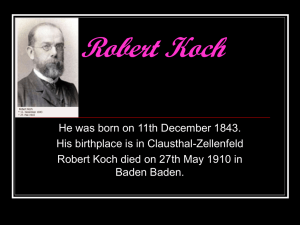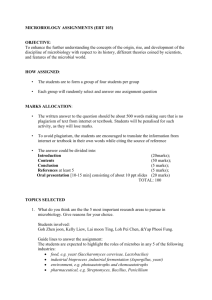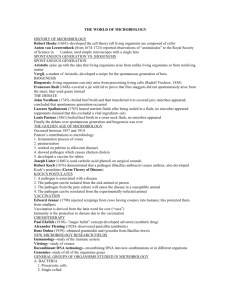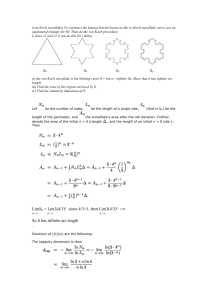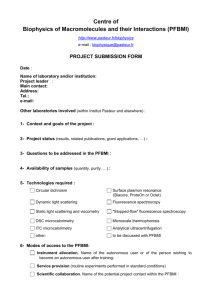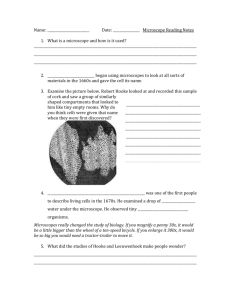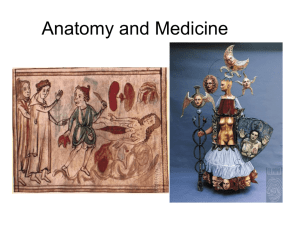History of Microbiology
advertisement
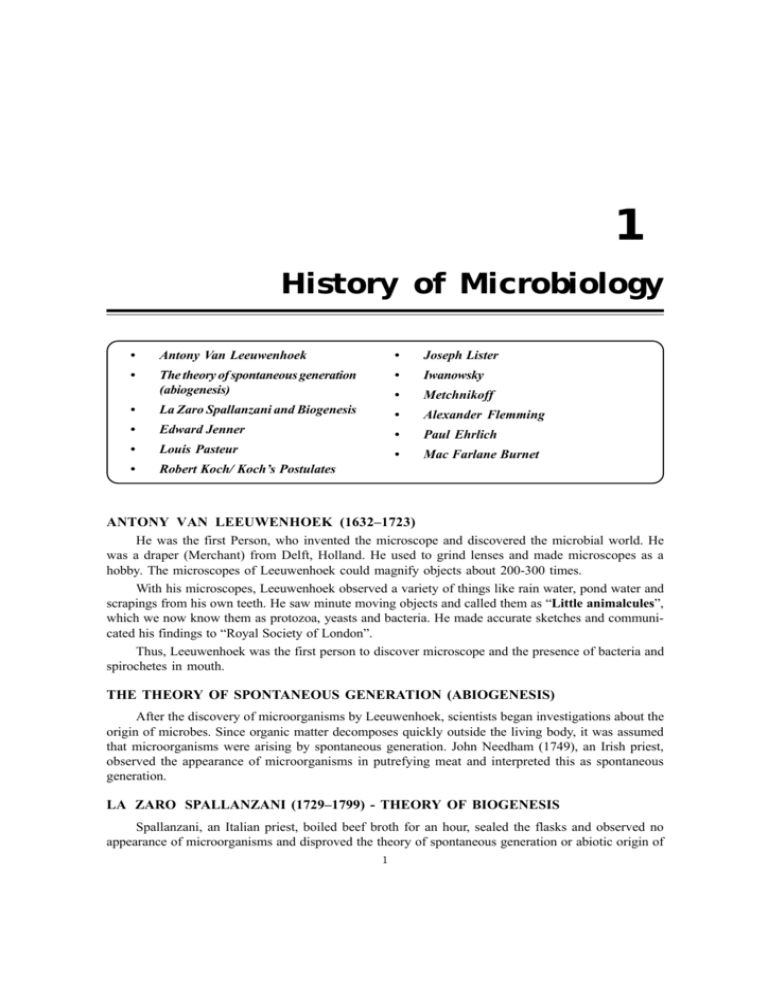
1 History of Microbiology • Antony Van Leeuwenhoek • Joseph Lister • The theory of spontaneous generation (abiogenesis) • Iwanowsky • Metchnikoff • La Zaro Spallanzani and Biogenesis • Alexander Flemming • Edward Jenner • Paul Ehrlich • Louis Pasteur • Mac Farlane Burnet • Robert Koch/ Koch’s Postulates ANTONY VAN LEEUWENHOEK (1632–1723) He was the first Person, who invented the microscope and discovered the microbial world. He was a draper (Merchant) from Delft, Holland. He used to grind lenses and made microscopes as a hobby. The microscopes of Leeuwenhoek could magnify objects about 200-300 times. With his microscopes, Leeuwenhoek observed a variety of things like rain water, pond water and scrapings from his own teeth. He saw minute moving objects and called them as “Little animalcules”, which we now know them as protozoa, yeasts and bacteria. He made accurate sketches and communicated his findings to “Royal Society of London”. Thus, Leeuwenhoek was the first person to discover microscope and the presence of bacteria and spirochetes in mouth. THE THEORY OF SPONTANEOUS GENERATION (ABIOGENESIS) After the discovery of microorganisms by Leeuwenhoek, scientists began investigations about the origin of microbes. Since organic matter decomposes quickly outside the living body, it was assumed that microorganisms were arising by spontaneous generation. John Needham (1749), an Irish priest, observed the appearance of microorganisms in putrefying meat and interpreted this as spontaneous generation. LA ZARO SPALLANZANI (1729–1799) - THEORY OF BIOGENESIS Spallanzani, an Italian priest, boiled beef broth for an hour, sealed the flasks and observed no appearance of microorganisms and disproved the theory of spontaneous generation or abiotic origin of 1 2 GENERAL MICROBIOLOGY life and proposed the theory of biogenesis. He said that every form of life takes its origin from their parents, germ cells or seeds. This theory of biogenesis was later proved and supported by Louis Pasteur. EDWARD JENNER (1749–1823) Jenner was an English country physician, who discovered a safe and efficient vaccination against small pox. which ultimately led to the eradication of small pox (Variola). Jenner observed that dairy workers, exposed to occupational cowpox infection were immune to small pox. He proved experimentally that resistance to small pox can be induced by injecting cow pox material (Vaccinia) from disease pustules into man (in 1796). Pasteur gave the general term “Vaccine” (Vacca = cow) in honour of Jenner’s cow pox vaccine, to various materials used to induce active immunity. Jenner published his findings in 1798 in a pamphlet “An inquiry into the cause and effect of variole vaccine”. LOUIS PASTEUR (1822–1895) Fig. 1.1 Edward Jenner (1749–1823) He was a Professor of Chemistry at the University of Lille, France. He is considered as “Father of Microbiology”, as his contribution led to the development of Microbiology as a separate scientific discipline. He proved the theory of “Biogenesis” and disproved the “Theory of spontaneous generation” (Abiogenesis), experimentally by using swan-necked flasks. He worked on souring of wine and beer and found that this alcohol spoilage is due to the growth of undesirable organisms, while the desirable microorganisms produce alcohol by a chemical process called “Fermentation”. He showed that wine did not spoil, if it is heated to 50-60°C for a few minutes. This method is called “Pasteurization”, now widely used in dairy units, to kill pathogenic microorganisms in milk. Fig. 1.2 Louis Pasteur (1822–1895) He is a founder of “Germ theory of disease” as he visualized that diseases are caused by microorganisms. In course of his research, he discovered the importance of sterilization and discovered steam sterilizer, autoclave and hot air oven. He also established the importance of cotton wool plugs for protection of culture media from aerial contamination. He differentiated between aerobic and anaerobic bacteria and coined the term “anaerobic” to refer to the organisms that do not require oxygen for growth. He worked on “Pebrine”, a silk-worm disease caused by a protozoan and showed that infection can be controlled by choosing worms free from the parasite for breeding. He developed the process of “attenuation” during his work on “chicken cholera” in fowls. He found that cultures which had been stored in the laboratory for sometime would not kill the animals as fresh cultures did. This attenuation is now used in protective vaccination against diseases. HISTORY OF MICROBIOLOGY 3 Pasteur showed that the anthrax disease in cattle and sheep is caused by a bacterium. He cultivated anthrax organisms in sterile yeast water, and showed that these cultures can produce disease when inoculated into healthy animals. He developed a live attenuated anthrax vaccine, by incubation at 40-42°C, which proved to be useful in protecting animals against anthrax. He also worked on swine erysipelas. Pasteur developed a vaccine against rabies (Hydrophobia), which made a greatest impact in medicine. He obtained the causative agent of rabies by serial intracerebral passage in rabbits and the vaccine was prepared by drying pieces of spinal chord. In 1888, Pasteur institute was established for mass antirabic treatment. Pasteur gave the general term “Vaccine” (Vacca=cow) in honour of Jenner’s cow pox vaccine, to various materials used to induce active immunity. ROBERT KOCH (1843–1912)/KOCH’S POSTULATES He was a German country Doctor who later became the Professor of hygiene and Director of institute of infective diseases at Berlin. He perfected many bacteriological techniques and known as “Father of Practical Bacteriology”. He discovered rod shaped organisms in the blood of animals, that died of anthrax. He experimentally obtained the anthrax organisms in pure culture on a depression slide by inoculation of infected blood into the aqueous humour of a bullock’s eye. He observed multiplication of bacteria and spore formation. He injected these spores into mice and reproduced the disease. He found that in certain conditions, the anthrax bacillus forms spores, that can survive on earth for years. He passed anthrax bacilli, from the blood of an infected animal, from one mouse to another through twenty generations, and found that they bred true. He Fig. 1.3 Robert Koch worked out its life-history. (1843–1912) He introduced staining techniques. He prepared dried bacterial films (Smears) on glass slides and stained them with aniline dyes for producing a better contrast under microscope. He discovered tubercle bacillus (Mycobacterium tuberculosis) which is popularly called as Koch’s bacillus. He injected tubercle bacilli into laboratory animals and reproduced the disease, satisfying all Koch’s postulates. He discovered Vibrio cholerae, the causative agent of cholera disease. He developed pure culture techniques by introducing solid media. The use of agar-agar obtained from dried sea weeds (Gelidium Sp.) in the preparation of solid bacteriological media was first suggested by Frau Hesse, the wife of Koch’ student. This agar-agar is totally inert with no nutritive value, solidifies at 45°C and melts at 90°C, and was found to be most suitable solidifying agent in the preparation of culture media. Koch isolated bacteria in pure cultures on these solid media. It revolutionized bacteriology. He discovered “Old Tuberculin”. Koch noted that when tubercle bacilli or its protein extract was injected into a Guinea-pig already infected with the bacillus, an exaggerated reaction took place and the reaction remain localized. This is popularly called “Koch Phenomenon” and it is a demostration of cell mediated immunity. The tuberculin test is based on Koch’s phenomenon. He erroneously thought that protein extracted from tubercle bacilli, called “Old tuberculin”, could be used in the treatment of tuberculosis. Koch did a series of experiments to fulfill the criteria laid by his teacher, Henle to establish the causative role between a particular microorganism and a particular disease. They are popularly known as Koch’s postulates (Henle-Koch’s Posulates). They are: 4 GENERAL MICROBIOLOGY 1. A specific organism should be found constantly in association with the disease. 2. The organism should be isolated and grown in a pure culture in the laboratory. 3. The pure culture when inoculated into a healthy susceptible animal should produce symptoms/ lesions of the same disease. 4. From the inoculated animal, the microorganism should be isolated in pure culture. 5. An additional criterion introduced is that specific anitbodies to the causative organism should be demonstrable in patient’s serum. JOSEPH LISTER (1827–1912) He is popularly known as “Father of antiseptic surgery”. He was a professor of surgey at University of Glasgow and Edinburg and later at King’s College, London. He was deeply interested in the prevention of post-operative sepsis. He was attracted by Pasteur’s germ theory of disease and concluded that sepsis or wound infection may be due to microbial growth, derived from the atmosphere. He successfully prevented post-operative sepsis by introducing antiseptic techniques. He chose carbolic acid (Phenol) and used as spray on the wound or during surgery. He applied dressings soaked in carbolic acid on wounds. As a result, there was a marked reduction of post-operative sepsis, wound inflammation and suppuraton. It saved millions of lives from the jaws of death due to wound infections. Lister’s antiseptic surgery later led to the development of aseptic surgery. He suffered many criticism but never lose courage and followed his own ideas and revolutionized the science of surgery by introducing antiseptic system in 1867. IWANOWSKY (1892) Dmitri Iwanowsky, a Russian botanist, occupies a pivotal position in the history of virology. In 1866, Adeolf E. Meyer, a Dutch agricultural chemist described a disease of tobacco called “Mosaic” and showed that the disease could be transmitted to healthy plants through the sap of the diseased plant. Iwanowsky (1892) demonstrated that this disease was caused by an agent which could pass through the filter, which withholds bacteria. He obtained the sap from infected leaves and passed it through a bacterial filter, called chamberland candle filter, which retained all bacteria and the filtered sap still retained infectivity when applied to healthy leaves. Beijerinck (1898), a Dutch Microbiologist, showed that this infectious agent could diffuse through an agar gel and that it was a non-corpuscular “Contagion vivum fluidum” which he called “Virus”. Stanley (1935), a British Mycologist was able to obtain the infectious agent of tobacco mosaic in a crystalline form. METCHNIKOFF (1845-1916) Elie Metchnikoff, the Russian-French biologist, discovered the phenomenon of phagocytosis, the cellular concept of immunity. In Italy, where he had gone on a research visit, he studied the transparent larvae of starfish and noticed some of their cells could engulf and digest foreign protein particles. These cell eaters are called “Phagocytes”. HISTORY OF MICROBIOLOGY 5 He continued his work on phagocytic action, at Pasteur Institute, Paris and found that in human blood a large proportion of the leucocytes (White blood cells) are phagocytic and attack invading bacteria. This, in turn, results in increased numbers of leucocytes in the infected areas followed by the inflamed area becoming hot, red, swelled and painful due to dead phagocytes forming pus. He spent his last two decades on the study of human aging, since he believed that phagocytes eventually begin to digest that host cells aided by the effects of intestinal bacteria and that effectively combating them would increase the life span of human being. ALEXANDER FLEMMING (1881–1955) Fig. 1.4 Elie Metchnikoff He was an English scientist worked at St. Mary’s hospital in London. (1845–1916) Flemming was associated with two major discoveries-lysozyme and penicillin. In 1922, he discovered lysozyme by demonstrating that the nasal secretion has the power of dissolving or lysing certain kinds of bacteria. Subsequently, he showed that lysozyme was present in many tissues of the body. In 1929, Flemming made an accidental discovery that the fungus Penicillium notatum produces an antibacterial substance which he called penicillin. Flemming was culturing Staphylococci in petridishes and some of his cultures were contaminated with a mold, subsquently identified as Penicillium notatum. Around the mold colony, there were clear zones, where Staphylococci disappeared. Flemming attributed this to the production of an anti-bacterial susbstance by the mold. Flemming cultured the fungus Penicilium notatum in broth cultures, filtered the fungal mat Fig. 1.5 Sir Alexander Fleming (1881–1955) and obtained the penicillin in soluble form in the culture filtrate. In 1940, Howard Florey and Ernst Chain demonstrated its antibacterial action in vivo. Working in U.S.A., they were able to produce large quantities of penicillin in pure form. In 1945, Flemming, Florey and Chain shared the nobel prize in physiology and medicine for the discovery of penicillin. PAUL EHRLICH (1854–1915) He was a German Bacteriologist, who pioneered the technique of chemotheraphy in medicine. From his discovery that certain tissues have a specific affinity, he reasoned that organisms causing diseases could be selectively killed with chemical drugs. This led him to produce “arsphenamine” (an arsenic compound), the first synthetic drug, which destroyed the syphilis microbe Fig. 1.6 Paul Ehrlich (1854–1915) in the body. Ehrlich observed that organic arsenicals killed trypanosomes in an infected animal, but, if smaller doses were administered, the trypanosomes acquired tolerance to the drug. Therefore, he aimed at “therapia magna sterilans” i.e., the introduction into the blood of a single dose of chemotherapeutic 6 GENERAL MICROBIOLOGY agent sufficient to kill the parasite. He also observed that drug would undergo certain changes in the body after it would produce the desired action. SIR FRANK MAC FARLANE BURNET (1967) Burnet is an Australian scientist, won nobel prize for the discovery of acquired immunological tolerance. He proposed clonal selection theory to explain antibody synthesis. His work on bacteriophages and method for culturing some viruses in live chick embryo, led him to the view that an animal’s ability is not inborn, but is developed during fetal life. Burnet (1967) developed concept of “immunological surveillance”. According to which the primary function of the immune system is to preserve the integrity of the body, seeking and destroying all “foreign” antigens, whether autogenous or external in origin. Burnet’s work also included the mode of action and the epidemiology of influenza virus, polio, Q fever and the cholera vibrio. QUESTIONS Short Notes 1. Louis Pasteur. 2. Robert Koch. 3. Koch’s Postulates. 4. Burnet. 5. Iwanowsky. 6. Joseph Lister. 7. Leeuwenhoek. 8. Jenner. 9. Flemming. 10. Metchnikoff. 11. Paul Ehrlich.

